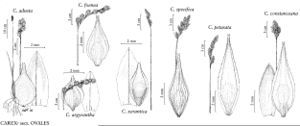Carex argyrantha
Amer. J. Sci. Arts, ser. 2, 29: 346. 1860.
Plants loosely cespitose. Culms 30–100 cm. Leaves: sheaths papillose, summits U-shaped; distal ligules 3.5–5 mm; blades 4–5 per fertile culm, green, without auricles, 17–37 cm × 2–5 mm, pliable. Inflorescences arching or nodding from proximal spike, open at least proximally, silvery greenish yellow, 2.5–6.5 cm × 7–17 mm; proximal internode 7–18 mm; 2d internode 3–10 mm; often aristate or long-aristate; proximal bracts scalelike. Spikes (3–) 7–15, widely spaced except the distal densely aggregated, proximal 1 often stalked, nearly globose or ovoid, 6–17 × 4.5–7 mm, base clavate or attenuate, apex rounded. Pistillate scales silvery pale green with pale or green midstripe, lance-subulate, (3.2–) 3.5–4.1 (–4.6) mm, shorter and narrower than or equaling perigynia, margin white-hyaline, to 0.6 mm wide, apex acute. Perigynia ascending to spreading, uniformly pale green to straw colored, conspicuously, evenly (4–) 5–8 (–10) -veined on each face, ovate to obovate, planoconvex, 3–4.5 × 1.9–2.3 mm, 0.6 mm thick, usually widest at 2/5–1/2 total length, margin flat, including wing 0.2–0.6 mm wide, finely granular-papillose; beak whitish at tip, flat, ciliate-serrulate to within 0.3 mm of tip, abaxial suture inconspicuous, distance from beak tip to achene 1.2–2 mm. Achenes oblongovate, 1.5–1.75 × 1–1.2 mm, 1.4–1.6 times as long as wide, 0.5 mm thick. 2n = 80.
Phenology: Fruiting mid summer.
Habitat: Dry clearings, open woods, on acidic, rocky, or sandy substrates, rock outcrops
Elevation: 0–700+ m
Distribution

N.B., N.S., Ont., Que., Conn., Maine, Md., Mass., Mich., N.H., N.J., N.Y., N.C., Ohio, Pa., R.I., Tenn., Vt., Va., W.Va.
Discussion
Selected References
None.
Lower Taxa
"shortened" is not a number."widest" is not a number."+timesaslongasinflorescences" is not declared as a valid unit of measurement for this property."not undefined" is not a number."shorter and narrower" is not a number.
